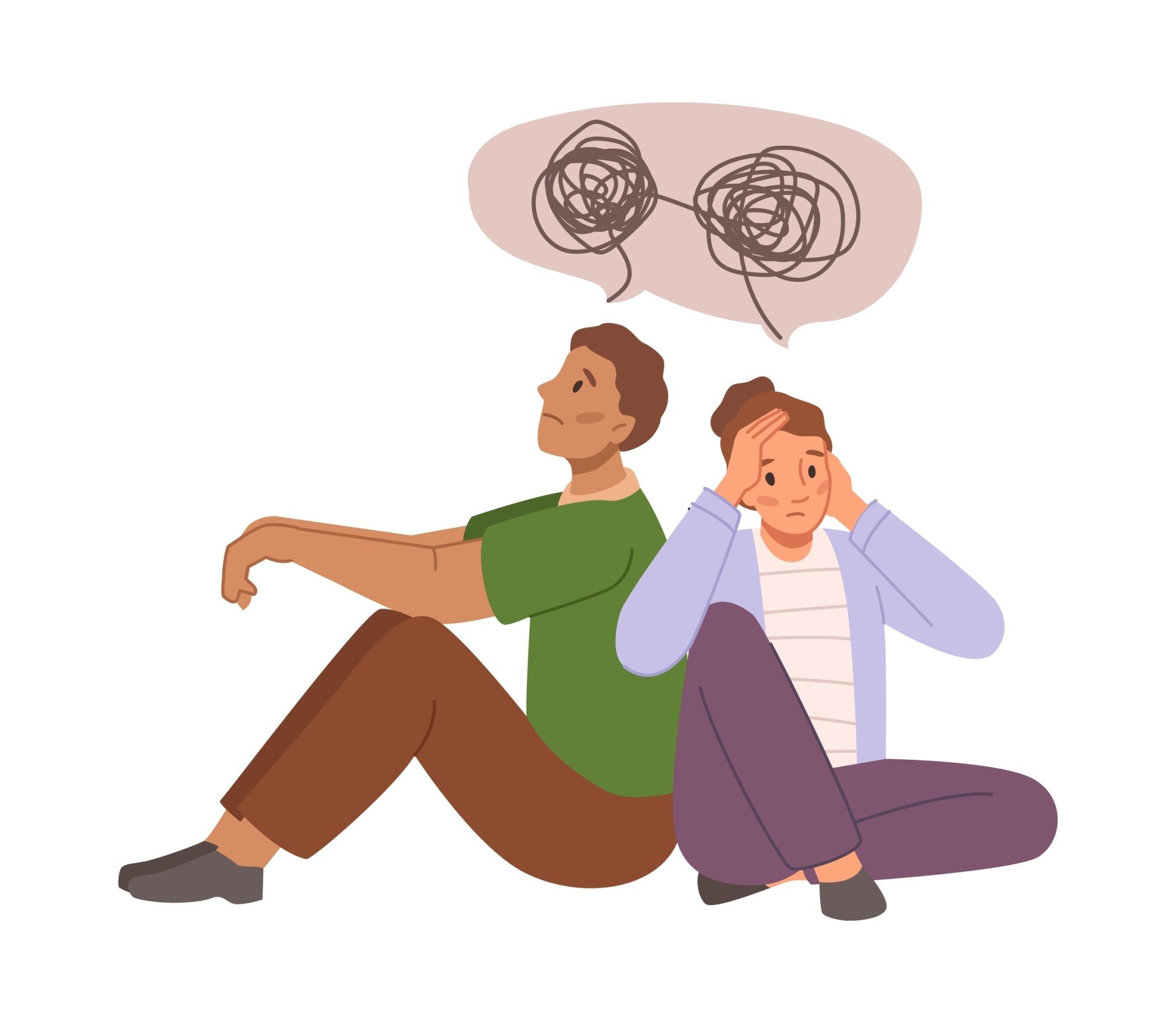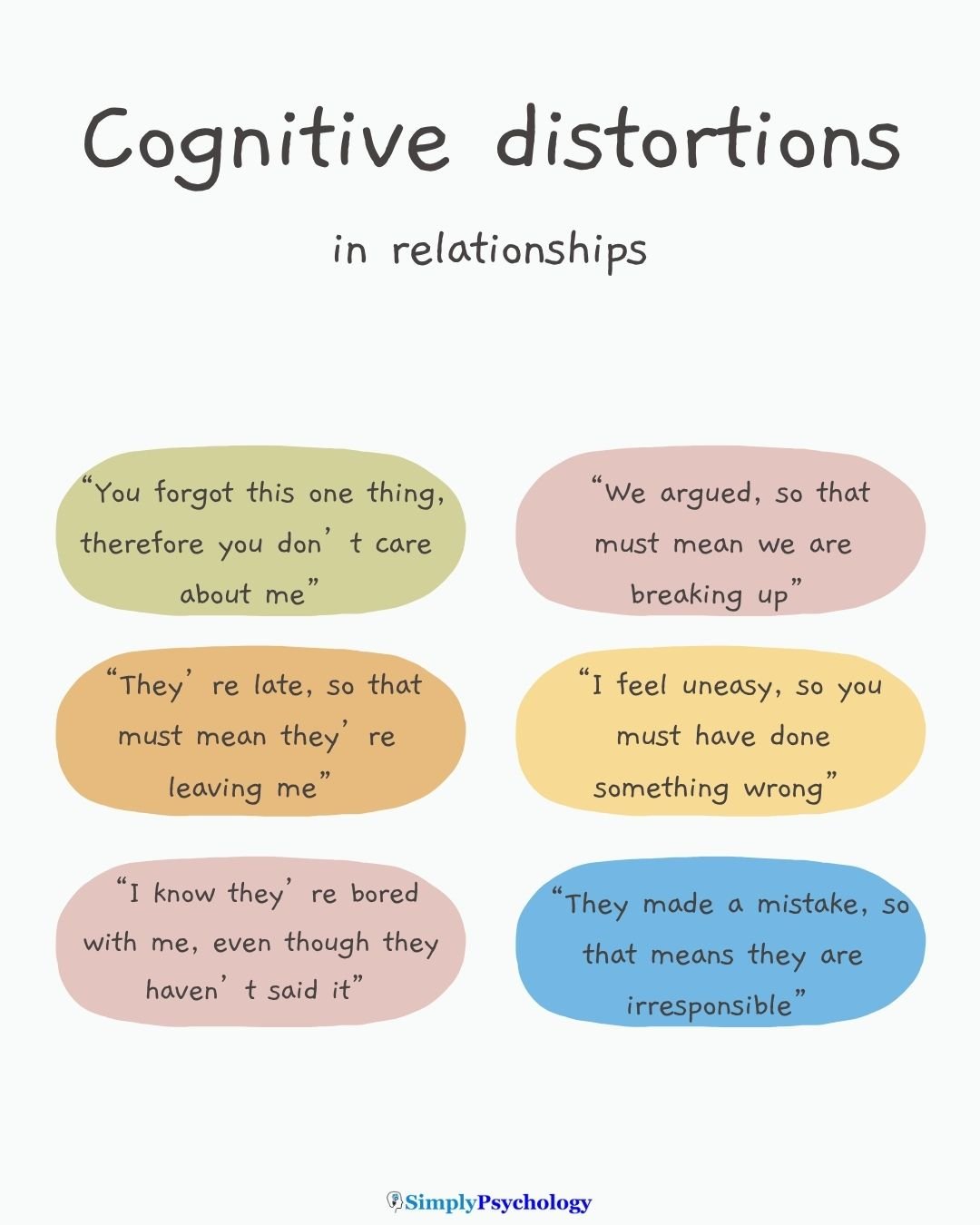Do you often assume your partner is angry when they’re quiet, or fear the worst after a minor disagreement?
This is common in relationships, and the way we think may be to blame. Our minds sometimes play tricks on us through cognitive distortions, which are like mental “filters” that twist how we interpret a partner’s words and actions.
This skewed thinking can create confusion, conflict, and emotional distance in even the strongest relationships.

It’s understandably frustrating to feel like you’re constantly overreacting or being misunderstood. By learning about these distorted thinking patterns, you can start recognizing and defusing them.
With a supportive approach, you and your partner can replace these habits with clearer, calmer ways of thinking and communicating.
Cognitive distortions are unhelpful, automatic patterns of thought that distort reality in our minds. Simply put, they are like mental biases or filters that cause us to perceive situations in an inaccurate, often negative way.
Common Cognitive Distortions in Relationships
Below are some of the most common cognitive distortions that tend to show up in romantic relationships, along with examples of how they manifest and why they are unhelpful.
1. All-or-Nothing Thinking (Black-and-White Thinking)
This distortion involves seeing things in extremes, with no middle ground—either something is perfect or terrible.
- Relationship Example: If your partner forgets one small promise, you conclude, “They never follow through on anything!” (ignoring all the times they do).
- Why It’s Unhelpful: This rigid mindset oversimplifies complex people and situations. It sets unrealistic standards and makes every minor mistake feel like a complete failure, ultimately fueling disappointment. Over time, it leaves you feeling like your partner is either “always supportive” or “never there for me,” rather than recognizing nuance.
2. Overgeneralization
Overgeneralization means drawing a broad, sweeping conclusion from one or two events. You take a single negative experience and assume it represents an unchangeable pattern.
- Relationship Example: “We had an argument last weekend, so I guess we’re always going to fight—maybe I’ll never have a happy relationship”. Or, one partner makes a mistake and the other thinks, “Yup, that’s how you’ll always be”.
- Why It’s Unhelpful: This distortion eats away at trust because you unfairly generalize a specific incident into “proof” of how things will always be. It leads to relationship pessimism, making it hard to give each other the benefit of the doubt.
3. Catastrophizing
Catastrophizing is when your mind jumps to the worst-case scenario and blows things way out of proportion.
- Relationship Example: If your partner is late to one dinner, you might think, “They must not care about me at all—what if this ruins our entire relationship?”. A minor disagreement spirals into “This is it, we’re going to break up”.
- Why It’s Unhelpful: It intensifies anxiety and panic over events that don’t warrant that level of fear, often causing overreactions that strain the connection. By constantly expecting doom, you create needless tension and may stifle the spontaneity and trust that a healthy relationship needs.
4. Personalization
Personalization involves taking things personally and blaming yourself for events that aren’t your fault, or conversely, unfairly blaming your partner for things beyond their control. It’s an “it’s all because of me” mentality.
- Relationship Example: You might think, “They seem distracted tonight—I must have done something wrong,” or “My partner is in a bad mood; it has to be because I didn’t do enough”. You assume every negative feeling or event is directed at you.
- Why It’s Unhelpful: This creates unwarranted guilt and defensiveness. It makes honest communication harder; if one partner always assumes “it’s my fault” or “you meant to hurt me,” it leads to resentment. Realize that not everything your partner does is a reaction to you—sometimes they’re just having a tough day.
5. Mind Reading
Mind reading is a distortion where you assume you know what someone else is thinking or feeling without actual evidence.
- Relationship Example: “I can tell they’re bored with me,” or “I know they’re attracted to that person at work, even though they haven’t said it”. You might not ask your partner what’s on their mind because you’ve already convinced yourself you “just know”.
- Why It’s Unhelpful: Mind-reading leads to huge misunderstandings. These assumptions are often just your own projected thoughts. When you act on unverified assumptions, it creates communication barriers and mistrust, making your partner feel unfairly accused.
6. Emotional Reasoning
This distortion means believing, “If I feel it, it must be true”. Your emotions become evidence of reality, even when facts don’t line up.
- Relationship Example: “I feel jealous and insecure, so my partner must be doing something untrustworthy,” or “I’m really upset; therefore, you obviously wronged me”.
- Why It’s Unhelpful: Our emotions, especially in heated moments, do not always reflect our partner’s actual intentions or the real situation. Emotional reasoning fuels conflict by overriding rational thinking; we stop looking at evidence and act solely on our feelings.
7. Filtering (Mental Filtering/Discounting the Positive)
Mental filtering means focusing only on the negative parts of an experience and filtering out all the positive aspects.
- Relationship Example: You dwell on the one criticism your partner voiced and ignore the ten compliments they gave. You zero in on “They forgot to take out the trash” and overlook that they cooked you dinner.
- Why It’s Unhelpful: This distortion creates a skewed view where it seems like nothing is ever good enough. Positive actions get dismissed, and only problems get magnified. Over time, filtering can seriously diminish the joy and appreciation in a relationship, leaving the partner feeling unacknowledged.
8. Labeling
Labeling is a form of overgeneralization where you assign a fixed, negative label to someone (or yourself) based on one instance or trait.
- Relationship Example: Instead of saying, “My partner forgot to pay the bill this month,” labeling would say, “My partner is so irresponsible and selfish”. Common labels thrown out during conflicts might be “She’s crazy,” or “He’s selfish”.
- Why It’s Unhelpful: It oversimplifies and dehumanizes your partner. Once we apply a nasty label, we tend to treat the person in line with that label and stop seeing their good qualities. It fuels anger and a lack of empathy. The antidote is to remember no one is defined by a single moment—we’re all complex.

Where Do These Thought Patterns Come From?
Cognitive distortions don’t emerge out of nowhere. Several factors contribute to developing these thinking habits.
Past Experiences and Trauma
If you’ve been through trauma or abandonment, you might have learned to expect danger or rejection.
This can cause you to brace for the worst in new relationships, leading to catastrophizing or mind-reading.
The brain creates these distorted interpretations as a protective reflex—it tries to “protect” you by assuming the worst.
Your brain is reacting to old scars, not necessarily your partner’s actual behavior.
Anxiety or Depression
People with anxiety disorders or depression are frequently affected by distorted thinking.
Anxiety can make you hyper-vigilant and prone to jumping to negative conclusions, while depression can tint everything in a negative light.
Rumination (repetitive negative thinking) reinforces these distortions, which are characteristic of conditions like generalized anxiety, major depression, and even post-traumatic stress.
Learned Family Dynamics
If your parents handled disagreements with blame, pessimism, or black-and-white statements, you likely absorbed those cognitive habits.
For example, a child whose family jumped to worst-case conclusions (“This is a disaster!”) may unconsciously mirror that catastrophizing in adult relationships.
These learned distortions can feel “normal,” but understanding you inherited a script gives you the power to rewrite it.
Personality Traits or Disorders
Certain personality types and disorders are associated with more distorted thinking. Individuals with Borderline Personality Disorder (BPD), for instance, often experience extreme all-or-nothing thoughts (sometimes called “splitting”) due to a deep-seated fear of abandonment.
Likewise, traits like perfectionism can feed distortions, such as all-or-nothing thinking (“Anything less than perfect means I’m a failure”).
Knowing the role of personality or neurodiversity can promote self-compassion, allowing you to manage the tendency rather than view it as a personal failing.
Signs Cognitive Distortions Are Affecting Your Relationship
How do you know if cognitive distortions are at play? Look for these common signs:
- Blow-Ups Over Small Issues: Frequent conflict over trivial things (a misplaced towel, a delayed text) is a red flag that one or both of you are perceiving more in the situation than is really there.
- Constantly Feeling Misunderstood or Walking on Eggshells: If you feel like your partner “just doesn’t get” what you’re trying to say, or one of you is always treading carefully to avoid upsetting the other, distortions are likely creating a communication barrier.
- Negative Assumptions Drive Your Reactions: Notice if you often react based on assumptions about what your partner meant or feels, rather than what they actually said or did.
- Difficulty Seeing Your Partner’s Perspective: When distortions run rampant, your own narrative—usually a negative one—dominates, making it hard to empathize. You might start viewing your partner as the villain during disagreements.
- Frequent Anxiety about the Relationship’s Status: This involves constantly doubting the relationship due to internal fears rather than your partner’s actions. If, after any disagreement, you start fearing a breakup or thinking, “this is it, we’re doomed,” that’s likely catastrophic thinking playing tricks on you.
If you notice these patterns, don’t panic; they’re clues that your mindset might need adjusting. By spotting them, you can begin to address the root cause (the distorted thoughts) rather than just the surface arguments.
How to Recognize and Challenge Cognitive Distortions
Tackling cognitive distortions is a process, but with practice, you can train your brain to think in more balanced ways. These practical steps may help:
1. Catch the Distortion
Start by identifying your negative thought patterns.
A thought journal or log can help you jot down distressing incidents, what you thought, and what you felt, which reveals patterns.
Simply catching yourself (e.g., noticing, “I’m labeling him right now” or “There I go catastrophizing this issue”) is a huge first step.
When you put a name to the pattern, it becomes easier to distance yourself from it.
2. Challenge the Thought
Once you spot a distorted thought, question it. Treat it like a hypothesis rather than truth.
Ask yourself: “What’s the evidence for this thought? What’s the evidence against it?”.
For example, if you think, “My partner doesn’t care about me,” list evidence that supports it (they forgot something important once) and evidence that contradicts it (they show care in many other ways).
You’ll often find the negative thought is an exaggeration or not 100% accurate.
3. Replace with a Balanced Thought
After poking holes in the distorted thought, reframe it to something more balanced and realistic. This is not forced “positive thinking,” but a fairer outlook.
- Original Distortion: “My partner doesn’t care about me” (Personalization/Labeling).
- Balanced Thought: “I’m upset that they forgot, but I know they’ve been caring in other ways. It’s likely an oversight, not a sign they don’t love me”.
By consciously swapping in a more reasonable thought, you teach your brain a new pattern, which can seriously reduce your stress and reactivity.
4. Reality-Check with Your Partner (Communicate)
Distortions thrive in silence and assumptions. A powerful way to challenge them is to open up gentle communication with your partner about what you were thinking—after you’ve calmed down.
Use a calm, non-blaming tone and “I” statements. For example: “I felt insecure when you didn’t say much at dinner, and my mind told me you were annoyed with me. Is that what you were feeling?”.
Checking in like this allows your partner to share their actual perspective, often defusing the distortion. By reality-testing your thoughts, you reinforce more accurate thinking.
Rebuilding Healthy Thinking and Communication
Challenging distortions paves the way for a stronger relationship. These supportive practices help foster clearer thinking and closer connection.
Pause Before Reacting
When emotions run high, take a breather.
This could mean counting to ten or stepping away for a short cool-down. Pausing prevents knee-jerk reactions driven by distorted thoughts.
If you feel a surge of anger, stop. Give yourself a moment to ask, “Is it possible I’m misreading this?”. A productive conversation is much easier once both people are calmer.
Practice Reflective Listening
Distortions worsen when we assume we know what our partner means.
Counter this with reflective listening: truly listen to your partner and then paraphrase what they said to ensure you understood correctly.
For example: “So you were hurt because I didn’t check in about how your day went, did I get that right?”.
This ensures each of you feels heard, and it can reveal if a cognitive distortion was coloring your view.
Accept “Subjective Realities”
In any disagreement, remember that both of you likely have valid perspectives.
Cognitive distortions often tell us there’s only one truth (our own). Try to approach conflicts with the mindset that your partner’s feelings and views are as real to them as yours are to you, even if they differ.
This is accepting that there can be two “subjective realities”. Embracing this idea helps you move away from blame (“You’re wrong, I’m right”) toward curiosity (“I see it this way, you see it that way—what can we learn here?”).
Use “I” Statements and Express Feelings Calmly
When bringing up an issue, frame it from your own perspective to avoid triggering defensiveness.
Say, “I feel upset when X happens,” instead of “You always do X wrong” (which is an overgeneralization/label).
This reduces the chance that your words will be distorted in your partner’s mind as a personal attack.
Focus on Reconnection and Reassurance
After working through a misunderstanding, make an effort to reconnect positively.
Explicitly reassure each other, as distortions can leave a residue of doubt. This might mean apologizing if you snapped based on a false assumption, or saying, “I appreciate you talking this out with me, I know we’re a team”.
Over time, building a habit of repair and reassurance strengthens trust, reinforcing that a moment of negative thinking is not a sign of doom.

